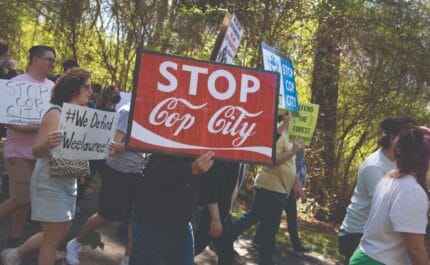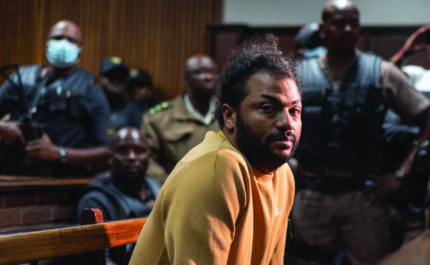Little Richard, 1932-2020
On 9th May 2020 one of the founding fathers of rock 'n' roll died at a family member's home in Tennessee. Little Richard's friend and official biographer Charles "Dr Rock" White remembers the life and times of one of pop music's true originals

9th May 2020 (Taken from: #39)
In September 1955 Richard Wayne Penniman walked into a New Orleans recording studio and transformed popular music with a kinetic blast of pure gibberish: “A-wop-bop-a-loo-bop, a-lop-bam-boom!”
Charles “Dr Rock” White, a longtime personal friend of the performer better known as Little Richard, remembers witnessing his explosive breakthrough hit, ‘Tutti Frutti’, performed live shortly before their first meeting, at the Granada theatre in Mansfield in 1962. “It was such an amazing experience,” says White, who in 1985 wrote the pop icon’s authorised biography, The Life and Times of Little Richard.
Now in his late 70s, White occasionally struggles to remember details, but his recollection of that night in a Nottinghamshire market town 58 years ago is vivid. “The spotlight fell on the piano and suddenly Little Richard came running down the aisle all dressed in white,” he says. “He leapt into the orchestra pit, then on to the stage, and he started hitting the piano. It was a mind-boggling experience, demented delirium all the way. He completely controlled the audience.”
“At one point he was on top of the piano, and then he fell off the piano and we thought he’d had a heart attack,” White continues. “He had perspiration falling off his head like diamonds in the spotlight. There was a silence in the hall but then suddenly he went ‘A-wop-bop-a-loo-bop!’ and the whole place went bananas.”
White first heard Little Richard as a teenager in rural Ireland, where flamboyant rock ’n’ roll singers were in short supply. “The most exciting thing to do there was watch the clouds go by,” he says. “I was just a kid and I went up to Dublin to buy a copy of [Little Richard’s 1958 song] ‘Good Golly Miss Molly’ because there weren’t shops selling that kind of stuff near me. And along with some friends I got this old gramophone, a wind-up one, and put on the song – and that was it. We played it all day long.”
By the time Little Richard and White crossed paths in Mansfield, the American entertainer was a household name, albeit one who had spent a few years out of the spotlight. ‘Tutti Frutti’, which Richard wrote while working in the kitchen of the Greyhound bus station in his hometown of Macon, Georgia, had sold over a million copies after its 1955 release. A string of subsequent hits, which also included ‘Long Tall Sally’, ‘Rip It Up’ and ‘Ready Teddy’, introduced an inimitable new talent to the world, while his explosive live performances were famed for generating something close to hysteria amongst those in attendance.
His performances were so powerful they nailed you to the wall. His voice was like a blast furnace”
In his book White describes a 1956 Little Richard concert in Baltimore: “People had to be restrained from jumping off the balcony… Suddenly something flew through the air and landed on [drummer] Chuck Connors’s hat – a pair of panties. One of the frenzied girls in the front had peeled off her briefs and thrown them at the band. Within seconds the air was filled with flying undergarments as many other girls followed suit.”
“As a showman he was extraordinary,” says White. “He was very clever and perceptive. His performances were so powerful he nailed you to the wall. His voice was like a blast furnace.”
It wasn’t just that he pounded the piano like his life depended on it and sang with the kind of evangelical fervour one might expect from the son of a preacher man. It was the entire package; the towering bouffant, the fabulous attire, the hollering and the preening, the makeup and the glitter. At a time of dehumanising segregation and rampant discrimination, this supremely confident bisexual black man was smashing gender and racial barriers. For the biography White spoke to producer HB Barnum, who said that in those unruly early shows, “Little Richard brought the races together. Although they still had the audiences segregated in the building… by the end of the night they would all be mixed together.”
That evening in Mansfield would have a huge impact on White’s life. Armed with a press pass for his hometown’s Roscommon Champion newspaper, he went backstage and chatted to Richard and soul singer Sam Cooke, who was also performing that night. “I just said to Richard, ‘I’ll give you a good write-up’, and he signed two of his albums and wrote his home address in Riverside, California, where he had bought a house for his mother and the family. And after that I just kept in touch with him.” Did Little Richard act like a superstar? “No, no. It was like meeting St Francis of Assisi, he was so polite and charming,” White replies.
They were an unlikely duo: an Irish podiatrist who ran a practice in Scarborough, and an African-American pioneer of rock ’n’ roll. But they became close friends and in the early 1980s White, who is known for his encyclopaedic knowledge of popular music and who presented a show on BBC Radio York for over 25 years, began work on his biography (“God has sent Dr Rock to write my life story,” Richard would tell him).
With its subtitle, ‘the Quasar of Rock’, reflecting White’s view of his friend as a glowing celestial object, an almost extraterrestrial arrival in the staid culture of the post-war years, the book is revelatory and often shocking. Featuring edited transcripts of extensive interviews with Richard and his friends, it depicts the performer’s formative experiences in Georgia: the difficulties of being a boy who was considered overly feminine, the horrors of racial violence in the South, the shock at learning that his father, Bud Penniman, had been murdered by his best friend – shot during an altercation at a local bar – and his extensive sexual experiences with both men and women when he was still in his early teens.
By the time ‘Tutti Frutti’ topped the R&B charts, with its original lyrics about anal sex replaced with something more wholesome, Richard had already spent years performing in travelling minstrel shows and drag-queen revues, not to mention Pentecostal churches where he sang gospel music. He was, throughout his life, a mass of contradictions, at once deeply religious and conservative and a hell-raising, rip-roaring wildman. He would keep his Bible by his side at drug-fuelled sex parties, of which there were many. “It was not unusual for participants in the famous after-show orgies to be woken up in the morning by an earnest Richard quoting passages from the gospels,” White wrote in his book.

Little Richard and Charles “Dr Rock” White in California in 1983
“He was a very complex man,” says White today. “I once said to Dr Anthony Clare, who presented the BBC programme In the Psychiatrist’s Chair, ‘You should have Little Richard on your show’. And he replied, ‘He has at least 16 different personalities that are constantly changing. I don’t think I could handle him.’”
While he was out in California to write the biography, White got to know Little Richard’s friends and family. “One time I flew into LA and even though it was close to midnight and I was very tired Richard met me and said, ‘Come on Dr Rock, we’re going to meet Ali,’” White recalls. “I didn’t know who he meant at the time but, of course, it was Muhammad Ali. I had to pinch myself. One time he introduced me to Jimi Hendrix, another time it was Ike Turner. On that occasion Richard said to me, ‘Dr Rock, if Ike offers you a puff from his pipe don’t take it because you’ll be out for days.’”
Although Little Richard still performed up until a few years ago, his heyday was short. Only a couple of years after the release of ‘Tutti Frutti’ he made a major life change after receiving what he believed was a message from God, urging him to change his ways. The burning star he apparently witnessed was, as the story goes, the Sputnik 1 satellite returning to Earth, but nevertheless he gave up rock ’n’ roll music and joined the ministry. As a certified minister, Richard officiated at the weddings of many celebrities including Demi Moore (to Bruce Willis), Cyndi Lauper and Tom Petty – although he was a less than reassuring presence at his own wedding in 1959. According to White’s book he turned up six hours late, leaving friends and family waiting until the middle of the night. It was perhaps no surprise that his marriage to Ernestine Campbell, a secretary from Washington DC, didn’t last long.
Although he returned to secular music around the time of his divorce in 1962 – the Mansfield concert was the second date of his comeback tour – Little Richard would never have another Top 10 hit in the US, his career derailed by drug and alcohol addiction. The last time White spoke to his friend was on his birthday in December 2019. “He was unwell and he had left his hotel suite [in his later years Richard lived in the penthouse at the Hilton in downtown Nashville] to be with family,” says White. “He had been declining for quite a while. I was amazed he’d lived so long because he’d had so many health crises.”
White explains how Little Richard inspired pretty much everyone who came after him. “I was backstage with The Rolling Stones and they absolutely worshipped him. The Beatles [who opened for Little Richard at a series of gigs in 1962 in Hamburg, Germany] also worshipped him and Paul McCartney wrote the introduction to my book.” In one memorable passage of the book, Richard recounts how Paul and George Harrison were “sweet” but that John Lennon was “nasty” and would upset him by doing a fart and fanning it around the room (“Sometimes he would do two in a row… It would bother me.”)
White doesn’t hesitate when asked where Little Richard belongs in the popular music canon. “Without a doubt, he is the most important of them all,” he replies. “So many people tried to copy his style, but he was the originator, he started it all. There was absolutely nobody else like him.”
Slow Journalism in your inbox, plus infographics, offers and more: sign up for the free DG newsletter. Sign me up
Thanks for signing up.








